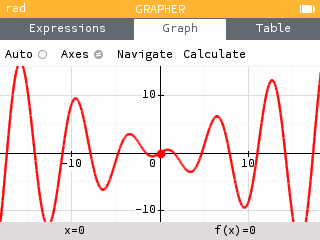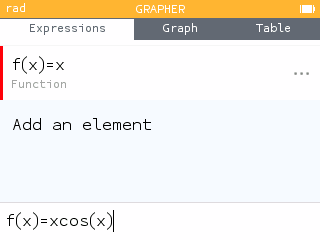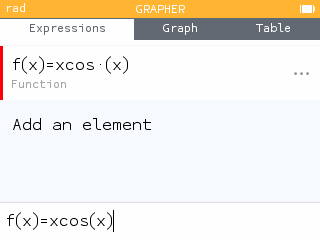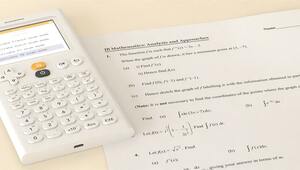
Nick Koberstein — June 01, 2022
An Improved Parser!
At some point in your mathematical journey, you may be interested in graphing the function f(x)=xcos(x). It’s a pretty neat looking graph!

However, before the release of software version 19, you may have ran into some issues. A blank graph and a table full of “undef” may have left you wondering what went wrong!

To understand this issue, and its fix, we must first consider what the calculator is doing whenever you press exe.
Understanding the parser
In her post To develop is to renounce!, Léa gave us a great insider’s view of what happens when you press exe on the NumWorks calculator.
One of the first things the calculator does is try to understand what you have written. If you write 13+2, the calculator first identifies the different ‘words’ in the calculation, which are the number 13, the symbol +, and the number 2. It then applies some grammar rules. You are doing this now by reading and comprehending this sentence. A number, followed by +, followed by a number, is the addition of the first number with the second.
This strategy of breaking down a statement into parts to understand it is called parsing.
Léa showed us that when we introduce variables and functions, things get complicated.
She has us consider abba(1+2):
- Is it the function
abbaapplied to1+2? - Is the variable
abbamultiplied by1+2? - Is it the variable
amultiplied by the variableb, multiplied by the variableb, multiplied by the variablea, multiplied by1+2? - Is it the variable
abbmultiplied by the functionaapplied to1+2?
Prior to version 19, our parser followed the rule: Always create the longest variable name possible and, if it is followed by parentheses, it is a function name. This rule is simple, but the user will have to write multiplication signs where they could be implicit.
And therein lies the issue you may have found when graphing f(x)=xcos(x).

Here, without the explicit multiplication between x and cos(x), the parser looks for the longest variable name, xcos. However, since xcos is not defined, we end up with the unknown variable xcos multiplied by the variable x, that is, xcos*(x). Since xcos is undefined, the function itself is undefined.
A proposed solution
When problem solving, it is important to consider several solution methods. When first approaching this problem, we considered automatically preceding functions such as sin(), cos(), ln(), etc with a multiplication symbol when using the keys or toolbox (e.g. *sin()). However, this would not solve the problem when these functions are typed in manually using the alpha keys or a computer keyboard on the emulator.
A better fix: Improve the parser!
To create a more universal fix, we needed to make adjustments at the parser level. This involved redesigning our parsing algorthim.
Implicit multiplication by default
By default we consider that ab means a*b. That is, unless ab is a defined variable or function, we assume implicit multiplicaton. (More on that below!)
To avoid a regression in the Solver application, we now support variable strings using quotation marks: "apple"+"pear"=12.
Right-to-left eager tokenizer
When parsing a string abc we’ll first consider abc, then bc, then c until we reach a defined function or variable or arrive at a single character. We then repeat this algorithm with the remaining string.
Consider our original function f(x) = xcos(x). How does our new parser read xcos?
Let’s consider some more examples.
The following symbols are defined: a, b, ab, azfoo and foobar. Also cos() and acos() are predefined functions.
-
How does our new parser read
abfoobar(x)?While
aandbare also defined, the parser will consider the entire stringabfirst. If you want to multiplyabyb, you will need to use the explicit multiplication symbol:a*b -
How does our new parser read
acos(x)?Here
aandcosare also defined. However, the parser will consider the entire stringacosfirst which is a predefined function. If you want to multiplyabycos, you will need to use the explicit multiplication symbol:a*cos -
How does our new parser read
azfoobar(x)?In this last example, you may wonder why the defined symbol
azfoowas not used. The parsing algorithm will eliminate the left most characters first. We could have gone in the other direction, but this behavior is a convenient way to give precedence to function over symbols. This gives usa*z*foobar(x)instead ofazfoo×b×a×r×(x).
Explore the calculator yourself! Look out for how the parser evaluates your input and do not hesitate to suggest improvements!

Nick Koberstein — Director of US Operations
Nick is one Director of US Operations. He taught high school mathematics for nine years in North Carolina and presented at local and national conferences. In addition to educational technology, Nick's other passions include music, board games, and growing avocado trees!

